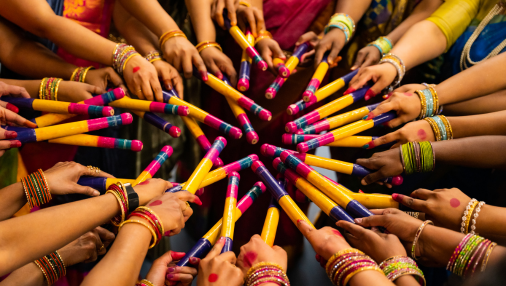Why We Celebrate the 9 Days of Navratri
1. Significance of Goddess Durga
Navratri is dedicated to Goddess Durga, the embodiment of divine feminine energy or Shakti. Mythology tells the story of Durga’s nine-day battle with the demon Mahishasura, which ended with his defeat. The festival symbolizes the triumph of dharma (righteousness) over adharma (evil). Each of Durga’s nine forms reflects qualities such as courage, wisdom, purity, and compassion, inspiring devotees to cultivate those virtues.
2. The Spiritual Meaning of Nine Days
Each day of Navratri is associated with a specific manifestation of the Goddess:
- Shailaputri — Daughter of the mountains, symbol of strength and devotion.
- Brahmacharini — Goddess of penance and meditation.
- Chandraghanta — Represents courage and serenity.
- Kushmanda — Creator of the universe through her divine smile.
- Skandamata — Nurturing mother of Kartikeya (Skanda).
- Katyayani — The fierce form who destroys demons.
- Kalaratri — Dark form who removes fear and negativity.
- Mahagauri — Goddess of purity and calmness.
- Siddhidatri — Bestower of supernatural powers and blessings.
These nine aspects guide devotees through a journey of inner growth — from strength and discipline to wisdom and fulfillment.
3. Symbolism: Good Over Evil
Beyond an epic tale, the Durga–Mahishasura conflict represents the inner battle everyone faces: conquering anger, pride, greed, and ignorance with devotion, self-control, and righteousness. Observances during Navratri — prayer, meditation, and fasting — help purge negative tendencies and align the mind toward higher values.
4. Fasting and Self-Discipline
Fasting is central to Navratri practice. Many devotees avoid grains, onion, garlic, and heavy foods, choosing light, sattvic meals, fruits, and milk-based items instead. Fasting is seen as a form of detoxification — physical, mental, and spiritual — that enhances focus, strengthens self-control, and deepens devotion.
5. Cultural Celebrations Across India
Navratri’s celebration varies by region, reflecting India’s cultural diversity:
- Gujarat: Garba and Dandiya Raas — energetic communal dances celebrating joy and devotion.
- West Bengal: Durga Puja — elaborate pandals and artistic idols culminating in grand festivities.
- Northern India: Ramlila and Dussehra — dramatic retellings of Lord Rama’s story and effigy burning of Ravana.
- South India: Golu displays — arranged dolls and family worship spanning the nine days.
These varied practices unite people across regions while celebrating local art, music, and community spirit.
6. Nine Nights of Inner Awakening
The nine nights can be seen as a progression of spiritual transformation: the first three nights honor Durga (removal of negativity), the next three honor Lakshmi (prosperity and well-being), and the final three honor Saraswati (knowledge and wisdom). This sequence symbolizes purification, the blessing of abundance, and the attainment of wisdom — a complete cycle of growth.
7. A Time for Unity and Joy
Navratri is also a festival of togetherness. Family members, friends, and communities gather for prayer, dance, music, and feasts. These shared experiences strengthen social bonds and infuse life with optimism and renewed purpose.
Conclusion
The nine days of Navratri are rich with spiritual meaning and cultural vibrancy. Celebrating Navratri is both an act of honoring divine feminine power and a personal journey to conquer inner darkness through devotion, discipline, and wisdom. Whether through fasting, prayer, dance, or community worship, Navratri revitalizes individuals and communities — a joyous reminder that light ultimately triumphs over darkness.

